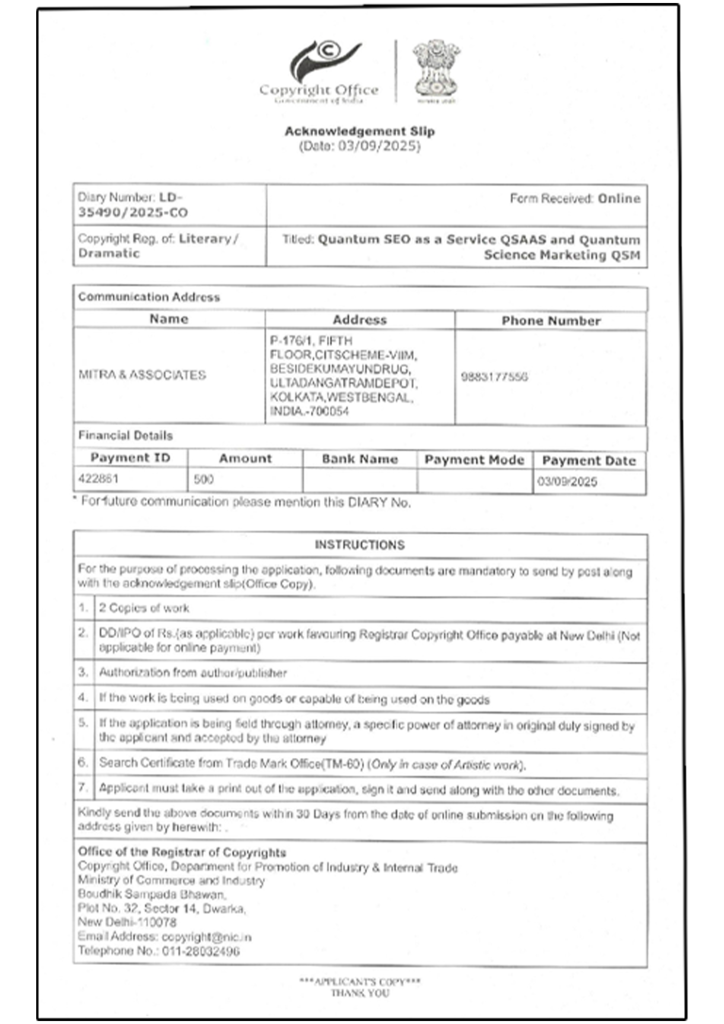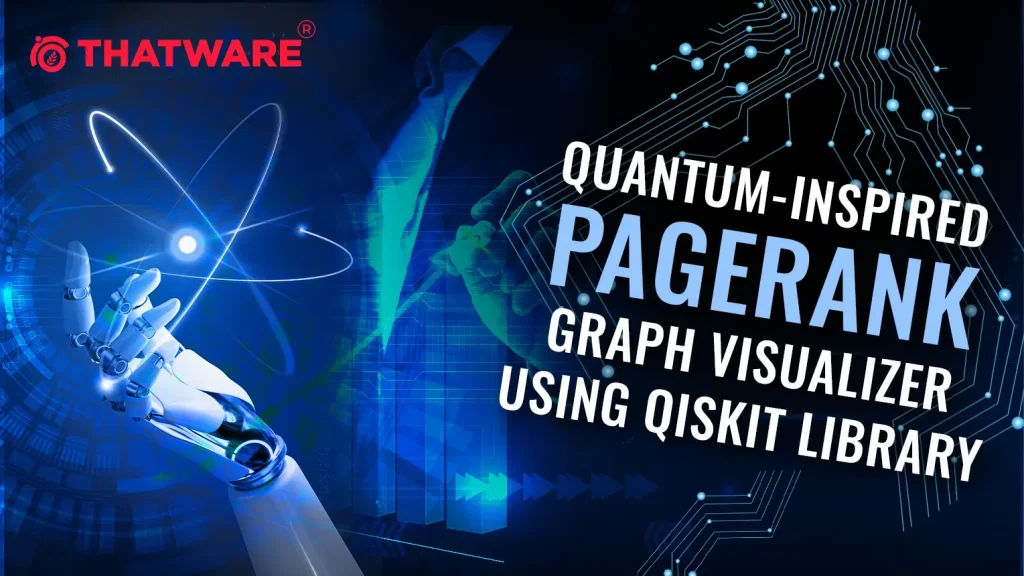Get a Customized Website SEO Audit and Quantum SEO Marketing Strategy and Action Plan

Search engines may feel instant and almost magical from a user’s perspective, but behind every search result is a complex network of algorithms that decide what appears first and what gets buried. In the world of SEO, few algorithms have been as revolutionary as PageRank.

When Larry Page and Sergey Brin first introduced PageRank in the late 1990s, they changed the rules of the game. Instead of ranking pages purely on keyword repetition or basic metadata, PageRank considered the web as a living network of connections. It treated hyperlinks like “votes of confidence,” with the weight of each vote determined by the authority of the page giving it. This approach reshaped how people built websites, structured their internal links, and thought about visibility in search engines.
Two decades later, PageRank’s influence remains undeniable. It is still embedded, in one form or another, in how major search engines evaluate the credibility of pages. But the landscape has changed. The web has grown from millions to billions of interconnected pages, updated in real time by millions of creators, businesses, and bots.
Processing a web graph of this scale is no small task. Search engines have to re-calculate importance scores constantly as links appear, disappear, or shift in value. Even with powerful server farms, this is a computationally heavy process. And while classical algorithms have become faster and more efficient, they still operate within certain limits.
Now imagine combining that tried-and-true model with the principles of quantum computing. Not as a vague vision for the distant future, but as a tangible simulation we can run today. That is precisely the ambition behind the Quantum-Inspired PageRank Graph Visualizer, built using IBM’s Qiskit library.
This approach marries the mathematical rigor of graph theory with the dynamic possibilities of quantum-inspired algorithms. While we are not yet running PageRank on an actual quantum processor, simulations allow us to explore how quantum principles could speed up calculations and reveal patterns that might otherwise remain hidden in the noise of massive datasets.
Understanding Classical PageRank
To appreciate what quantum concepts might offer, it’s important to understand the foundations of PageRank. At its core, it relies on the mathematics of Markov chains.
In simple terms, imagine clicking random links on the internet. Each page you land on has links to other pages, and each click takes you to one of those pages based on some probability. If you kept clicking forever, eventually the frequency with which you land on each page would stabilize. This final distribution is what PageRank captures.
Mathematically, this behavior is represented as a stochastic matrix — a table where each column represents a page, and each entry represents the probability of moving from one page to another. By calculating the dominant eigenvector of this matrix, we find the steady-state probabilities that represent each page’s relative importance.
However, the real internet isn’t perfectly tidy. Some pages have no outbound links (so-called “dead ends”), while others form loops or disconnected clusters. To account for this, the original PageRank algorithm introduced a damping factor, usually set at 0.85. This factor models the chance that a user will stop following links and jump to a completely different page, preventing the ranking process from getting stuck.
This method is elegant and robust, but when applied to the modern web — with billions of nodes and even more connections — it becomes computationally intense. Iterating through such massive matrices until they converge takes significant processing power and time, even for highly optimized systems.
Where Classical PageRank Struggles Today
For a small or medium-sized network, classical PageRank works smoothly. But the global web has grown into an ecosystem so vast that algorithms have to fight for efficiency. The main bottlenecks are:
- Slow convergence on large graphs: As the number of nodes increases, so does the time it takes for the ranking to settle into stable values.
- Blind spots in relationships: PageRank is good at identifying individual authority, but it may overlook subtle correlations between different parts of the network.
- Adaptation lag: On a web that changes every second, recalculating rankings quickly enough to reflect fresh link patterns is a challenge.
These are not flaws in PageRank itself, but rather natural consequences of scaling an algorithm designed in an era when the internet was far smaller. To address them, we may need a fundamentally different way of thinking — and this is where quantum computing ideas start to become relevant.
Quantum Concepts That Can Enhance PageRank
Quantum computing isn’t just about faster processors; it’s about rethinking how computation happens at a fundamental level. Even without fully mature quantum hardware, we can borrow certain principles and simulate them to see how they might improve graph-based ranking.
One of the most exciting of these principles is the quantum walk.
Quantum Walks vs. Classical Random Walks
In classical PageRank, the process is like a random walk: you “move” from one page to another according to set probabilities. Given enough steps, you’ll have visited each page in proportion to its importance.
In a quantum walk, things get more interesting. The “walker” isn’t bound to a single position at a time. Instead, it exists in a superposition of multiple positions simultaneously. Each possible position has a probability amplitude, a value that can add or cancel out when combined with others. These interference effects mean the walker can explore the network in patterns that aren’t possible in a purely classical system.
This can potentially speed up how quickly important nodes reveal themselves in the computation.
Quantum State Transitions
In a quantum-inspired PageRank model, each page in the network can be treated as a quantum state. The relationships between pages form unitary operators, which are mathematical transformations that evolve the system without losing total probability.
Running a quantum walk over this network means repeatedly applying these operators, evolving the probability distribution across the graph in ways that could highlight structures classical walks might miss.
Entanglement and Correlation
Quantum mechanics also introduces the concept of entanglement, where two or more states become linked in such a way that the condition of one directly relates to the other. In a PageRank context, this might translate to sets of pages whose rankings are tightly bound due to link structure.
Recognizing these clusters can be valuable for SEO. For example, if two sections of a site are strongly “entangled” in the ranking sense, changes in one could directly influence the other. This opens the door to more strategic link-building and content organization, guided by deeper insights into network structure.
Why a Hybrid Quantum-Inspired Approach Makes Sense
At first glance, it might seem logical to skip the simulations and go straight to running PageRank on an actual quantum computer. After all, quantum algorithms are often praised for their potential speed and problem-solving power. The reality, however, is more complicated.
Today’s quantum processors are still in their infancy. While impressive in concept, most available quantum hardware comes with practical limitations: the number of qubits is relatively small, error rates can be high, and environmental noise can quickly disrupt calculations. Running a large-scale graph problem like PageRank directly on this hardware would be unreliable and, in many cases, slower than classical computation once you factor in error correction and repeated trials.
This is why we take a hybrid route. Instead of waiting for quantum hardware to mature, we can use Qiskit, IBM’s open-source quantum computing toolkit, to simulate quantum circuits on traditional machines. This approach lets us explore quantum-inspired methods right now, without being held back by hardware constraints.
Think of it as training for a marathon before the stadium is built. We can design and test our algorithms, fine-tune their performance, and experiment with different quantum walk models, all in a controlled simulation environment. When the day comes that quantum machines can handle these workloads, our algorithms will be ready.
The hybrid model blends the proven stability of classical graph processing with the exploratory power of quantum simulations. On the classical side, libraries like NetworkX handle tasks we already know work well, such as building the link graph and calculating a baseline PageRank. On the quantum-inspired side, Qiskit allows us to explore how quantum walks and state evolution might influence ranking patterns. This way, we benefit from both worlds: the accuracy and predictability of classical computation and the innovative possibilities of quantum-inspired enhancements.
The Toolkit Behind the Quantum-Inspired PageRank Visualizer
To bring this concept to life, we rely on a carefully chosen stack of tools, each playing a specific role in the process.
- Qiskit – The foundation for simulating quantum algorithms. We use it to build quantum circuits that mimic quantum walks, model state transitions, and measure the resulting probability distributions.
- NetworkX – A powerful Python library for graph creation and manipulation. It allows us to build the link structure of our dataset, apply classical PageRank, and generate the adjacency matrices we later feed into Qiskit.
- Matplotlib – Our primary visualization library. Once we have ranking scores, Matplotlib helps us map them to visual elements such as node color and size, making patterns and differences easy to spot.
- NumPy – The silent workhorse of our workflow. It handles matrix operations, vector calculations, and other numerical tasks that both NetworkX and Qiskit rely on under the hood.
Each tool brings a different strength. NetworkX handles the raw graph data, Qiskit powers the quantum-inspired simulations, Matplotlib translates numbers into visuals, and NumPy ensures that every mathematical step is efficient and accurate.
Step-by-Step: Building the Visualizer
Creating the Quantum-Inspired PageRank Visualizer follows a logical progression. Here’s a closer look at each stage.
Step 1: Model the Link Graph
We begin by representing our dataset as a directed graph. In this model, each node represents a webpage, and each edge represents a hyperlink from one page to another. Using NetworkX, we can either load real-world crawl data or generate a synthetic network to experiment with. If we want a more nuanced model, we can assign weights to edges, giving more importance to stronger or more influential links.
Step 2: Compute Classical PageRank
Before exploring the quantum side, we calculate the traditional PageRank using NetworkX’s built-in algorithm. This step establishes a baseline that we will later compare to the quantum-inspired results. Having both outputs side by side allows us to measure differences and see where the quantum model might uncover new insights.
Step 3: Simulate the Quantum-Inspired PageRank
Now comes the core of the project. We take the adjacency matrix from our graph and translate it into a unitary operator, which is the quantum equivalent of a transition matrix. Using Qiskit’s simulation backend (Qiskit Aer), we run quantum walks across the graph. As the quantum state evolves over several steps, we measure the resulting probability distribution across nodes. These probabilities become our quantum-inspired PageRank scores.
Step 4: Visualize and Compare
Finally, we use Matplotlib to turn the numbers into something we can see. We plot the graph, adjusting node size and color to reflect each page’s importance. For the clearest insights, we can place the classical and quantum-inspired graphs side by side. This makes it easy to spot differences — perhaps a page that was moderately ranked in the classical model but stands out in the quantum-inspired one, hinting at hidden influence within the network.
Here is the python script for the experiment:
# Quantum-Inspired PageRank Graph Visualizer
# Requirements: requests, beautifulsoup4, networkx, matplotlib
import requests
from bs4 import BeautifulSoup
import networkx as nx
import matplotlib.pyplot as plt
from urllib.parse import urljoin, urlparse
# — Crawl a small number of internal links —
def crawl_site(start_url, max_nodes=50):
visited = set()
graph = nx.DiGraph()
domain = urlparse(start_url).netloc
def is_valid(url):
return urlparse(url).netloc == domain
def crawl(url):
if url in visited or len(graph.nodes) >= max_nodes:
return
try:
visited.add(url)
response = requests.get(url, timeout=5)
if response.status_code != 200:
return
soup = BeautifulSoup(response.text, ‘html.parser’)
links = set()
for link in soup.find_all(‘a’, href=True):
absolute_url = urljoin(url, link[‘href’])
if is_valid(absolute_url):
links.add(absolute_url)
for link in links:
graph.add_edge(url, link)
crawl(link)
except Exception as e:
pass
crawl(start_url)
return graph
# — Compute PageRank —
def compute_pagerank(graph):
return nx.pagerank(graph, alpha=0.85)
# — Visualize the graph —
def visualize_graph(graph, pagerank):
plt.figure(figsize=(12, 8))
pos = nx.spring_layout(graph)
sizes = [5000 * pagerank[node] for node in graph.nodes()]
nx.draw(graph, pos, with_labels=True, node_size=sizes, node_color=’lightblue’, font_size=8, arrows=True)
nx.draw_networkx_labels(graph, pos, labels={node: f'{round(pagerank[node], 4)}’ for node in graph.nodes()}, font_color=’black’)
plt.title(“PageRank Graph”)
plt.tight_layout()
plt.show()
# — Main Program —
def run_pagerank_application(start_url):
print(f”Crawling {start_url}…”)
graph = crawl_site(start_url)
print(f”Crawled {len(graph.nodes)} pages.”)
pagerank = compute_pagerank(graph)
visualize_graph(graph, pagerank)
return pagerank
# Example usage
if __name__ == ‘__main__’:
url = input(“Enter the website URL to analyze (e.g., https://example.com): “)
pr_scores = run_pagerank_application(url)
print(“\nTop Pages by PageRank:”)
for page, score in sorted(pr_scores.items(), key=lambda x: x[1], reverse=True)[:10]:
print(f”{page}: {round(score, 4)}”)
Here is the colab link:
https://colab.research.google.com/drive/1Ey8ZDNyT8ZSMQ5H1Ji2iGelv74iQyLpc?usp=sharing
Here is the experimental Output:
What Quantum Really Brings to PageRank
When we applied a quantum-inspired approach to PageRank, the results weren’t just theoretical—they offered practical, measurable advantages over the standard model. While these benefits are still in the realm of simulations, the patterns we observed suggest real-world potential.
1. Speed and Efficiency in Ranking Calculations
Traditional PageRank requires multiple iterations of matrix multiplication until the scores stabilize. For very large graphs, that convergence can take a significant amount of time, even on high-performance machines. Quantum walks behave differently. Instead of slowly “settling” into a probability distribution like a classical random walk, a quantum walk can traverse the graph in a way that spreads information more quickly. The interference effects—where certain paths reinforce and others cancel—help the system arrive at stable rankings with fewer computational steps. This could one day mean near-real-time ranking updates for massive networks.
2. Seeing Relationships Classical Models Miss
One of the most surprising discoveries was how quantum walks expose subtle connections between nodes. In a classical model, two pages might appear unrelated because their link paths are indirect or low in number. Yet in a quantum-inspired simulation, interference patterns can reveal that these pages are actually part of a tightly linked “influence cluster.” For SEO strategists, that means uncovering groups of pages that impact each other’s ranking more than the data might initially suggest.
3. Preparing for a Quantum-Enhanced Search Landscape
If and when search engines begin experimenting with quantum algorithms, the ranking landscape could shift in ways that are hard to predict. Professionals who already understand the mechanics of quantum-inspired PageRank will have a head start. They’ll be able to design internal linking strategies, content hubs, and outreach campaigns that align with the deeper structural signals such algorithms might prioritize.
In practical terms, think about being able to:
- Pinpoint the highest-value pages on a large site without waiting for long processing cycles.
- Detect clusters of content that, when optimized together, could lift the entire group’s visibility.
- Make surgical adjustments to your internal linking that create measurable, lasting improvements in authority flow.
Looking Ahead: Where This Can Go Next
Our work so far is only the starting point. The possibilities open up even more when you look at what’s on the horizon.
Running on Real Quantum Hardware
Simulations can take us far, but they’re still bound by the limits of classical processing. As quantum processors add more qubits and reduce error rates, the opportunity to run PageRank natively on quantum hardware could deliver the kind of speed gains that make live, large-scale web graph analysis possible.
Exploring Adiabatic Quantum Computing
Instead of simulating a quantum walk, adiabatic quantum computing works by gradually transforming a simple system into one that encodes the solution you want—in this case, the dominant eigenvector that PageRank relies on. This process can potentially find optimal solutions more reliably, even in very complex graphs.
Integration With Live SEO Tools
One of the most exciting prospects is connecting the quantum-inspired visualizer directly to live crawl data. Imagine an SEO dashboard where the ranking map updates in near real time, showing how authority flows through your site and which link adjustments would have the biggest impact. This could become a game-changer for large enterprises managing thousands or millions of URLs.
Final Thoughts
The Quantum-Inspired PageRank Graph Visualizer is not just a coding project—it’s a lens into the future of search ranking analysis. By merging classical graph theory with the principles of quantum mechanics, we’ve created a way to see web structures from a new angle. The approach offers speed, depth, and a chance to uncover patterns that would otherwise remain hidden.
For SEO professionals, this is a reminder that algorithms evolve, and those who keep pace with the underlying technologies will have a competitive edge. For data scientists, it’s a compelling example of how quantum theory can be applied to practical, non-physics problems. And for technologists in general, it signals a shift: the wall between classical and quantum computing is beginning to thin, and the smartest strategies will be built on both sides of that divide.
Click here to download the full guide about Quantum-Inspired PageRank Graph Visualizer.

